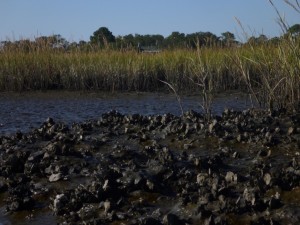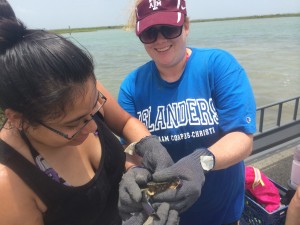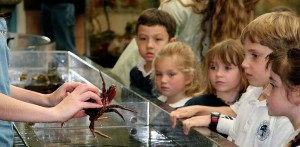Who We Are
What We Did
We traveled to the Port Aransas Marina with Avery Scherer to collect Mud crabs for one of her predator prey experiments. The goal of the trip was to collect 70-80 adult mud crabs as well as about 100 juvenile crabs. At first it was difficult to see the crabs camouflaged on the oyster reef, but after some time searching I trained my eyes to see them much better. The trick was looking for the little hits of purple on the crabs, that’s what helped me the most.
We spent the day walking and swimming around the oyster reef searching for mud crabs. Walking on the oyster reef proved to be much more difficult than I had thought. With every step on the oyster reef I could hear the crushing of the brittle shells below my feet which made me feel kind of bad for the oysters. Avery explained how oysters build off each other, so that eased my mind. The oyster shells were also very sharp and the sand between the clusters was like quick sand. By the end of the trip my tennis shoes were shredded, but that was fine with me. We had a very productive day catching the mud crabs.
After catching the crabs we placed them in buckets with bubblers(used to oxygenate the salt water) for safe traveling back to campus.
What We Learned
I learned so much on this trip. I never knew there was an oyster reef in Port Aransas and I have lived in this area all of my life! The reef is literally about 10 minutes from the marina, just past the ferry boats, and right next to Charlie’s Pasture.
I learned the importance of safety while walking on an oyster reef. Proper foot wear and a nice pair of gloves(that feel like a chor-boy) can tremendously cut down on the amount of damage done to your body while walking on the sharp shells. Sunscreen! I have very fair skin and I burned while out there even though I applied sunscreen multiple times.
While Avery and I were looking for Mud crabs we noticed a pair of Blue crabs. Avery pointed out to me that they were a mating couple and that when a female is ready to mate she molts and her shell becomes very soft which is better for mating. The male crab stays with the female even after mating until her shell hardens up to protect her and the future offspring. I thought that was very interesting and was something new to me.
Questions We Have
Do the advantages of catching the Mud crabs far outweigh the disadvantages? I noticed how when walking on the reef I was destroying the reef as well. So rebuilding must take a substantial amount of time. Does removing such a large amount of Mud crabs off set the ecosystem on the reef? Maybe there is another way to do this type of research and not harm the reef as much.
Connections to Teaching
This lesson taught me how important safety is for experiments. Having the right materials can make an experiment so much easier! I would use this experience to teach about the importance of safety.
This trip also made me wish for a salt water aquarium in my future classroom. We could use it to do experiments, chart growth of organisms, and examine sea life.



